Types of Agate With Photos
Agate
Agate is a variety of chalcedony, which is a microcrystalline form of quartz. It is characterized by its banded or layered appearance, with alternating colors and patterns. These bands are often curved or concentric, creating unique and visually striking designs. Agate forms in cavities within volcanic or sedimentary rocks, where silica-rich fluids deposit layers of quartz over time. Agate can be found in a wide range of colors, including blue, green, red, yellow, and white.
Agate forms when silica-rich fluids fill cavities in rocks (such as gas bubbles in volcanic lava). Over time, the silica precipitates out of the fluid, forming layers of microcrystalline quartz. The banding is caused by variations in the composition or impurities in the silica-rich solutions. Cryptocrystalline means that the mineral crystals are so fine that they are only vaguely seen in patterns and fine variations.
Where to Find Agate
Most agates occur as nodules in volcanic rocks or ancient lavas, in former cavities produced by volatiles in the original molten mass, which were then filled, wholly or partially, by siliceous matter deposited in regular layers upon the walls. Agate has also been known to fill veins or cracks in volcanic or altered rock underlain by granitic intrusive masses. Such agates, when cut transversely, exhibit a succession of parallel lines, often of extreme tenuity, giving a banded appearance to the section. Such stones are known as banded agate, riband agate and striped agate.
Many agates are hollow, since deposition has not proceeded far enough to fill the cavity, and in such cases the last deposit commonly consists of drusy quartz, sometimes amethystine, having the apices of the crystals directed towards the free space so as to form a crystal-lined cavity or geode.
Note: Agate is not simply "banded chalcedony." There are other types of chalcedony that are banded that do not match the description above, banded flint, for example.
Agate Types and Varieties
It's unlikely we'll ever have a complete list of all the names for Agate, since there are already hundreds of old ones and new ones are being made up all the time, often without any input from the scientists who actually study and classify the rocks. Some variety names are used by collectors and dealers, but there are tons more invented by dealers to describe a specific location or other characteristics. The varieties listed below are the ones you're most likely to come across.
There are various types of agate, including Moss Agate, Fire Agate, Blue Lace Agate, Crazy Lace Agate, Dendritic Agate, Botswana Agate, Laguna Agate, Turritella Agate, Eye Agate, Condor Agate, Enhydro Agate, and Iris Agate.
There are a number of varieties of chalcedony that are called "agate" that do not match the definition given above. Good examples are "feather agates" and "fire agates". These are listed as varieties of chalcedony, not as varieties of agate.
Onyx Agate
 |
| Onyx-Agate from Minas Geraís, Brazil. Collection:Technical University Kosice. Photography by Ivan Karas |
Onyx is formed of bands of chalcedony in alternating colors. It is cryptocrystalline, consisting of fine intergrowths of the silica minerals quartz and moganite. Its bands are parallel to one another, as opposed to the more chaotic banding that often occurs in agates. The colors of its bands range from white to almost every color (save some shades, such as purple or blue). Commonly, specimens of onyx contain bands of black and/or white.
Sardonyx is a variant in which the colored bands are sard (shades of red) rather than black.
Iris Agate
Iris Agate is a mesmerizing variety of agate known for its captivating display of rainbow colors when illuminated from behind. It's a finely banded agate, meaning it has thin layers of different colored chalcedony. When cut into thin slices and backlit, these layers diffract light, creating a stunning iridescent effect similar to a rainbow. t is named after the Greek word "iris," which means "rainbow" or "rainbow-like appearance," aptly reflecting its characteristic feature.
In its natural state, iris agate may appear like any other ordinary agate, with a solid or banded color. However, its magic unfolds when sliced into thin sections and illuminated from behind. This process reveals a mesmerizing play of colors, showcasing the entire spectrum of the rainbow. Iris agate is found in various locations worldwide, including Brazil, Madagascar, and the United States.
Crazy Lace Agate
Crazy Lace Agate is a variety of banded Chalcedony, It is predominantly white, with layers of creamy browns, blacks and grays. Some may include layers of yellow ochre, gold, scarlet and red. Agate is sometimes called the earth rainbow because, in its various forms, the concentric bands in nature form nearly every color the earth can produce, including a colorless form.
Thunder-egg Agate
Thunder-egg is a nodule-like rock, similar to a filled geode, that is formed within rhyolitic volcanic ash layers. Thundereggs are rough spheres, most about the size of a baseball- though they can range from less than an inch to over a meter across.
They usually contain centres of chalcedony which may have been fractured followed by deposition of agate, jasper or opal, either uniquely or in combination. Also frequently encountered are quartz and gypsum crystals, as well as various other mineral growths and inclusions.
Enhydro Agate
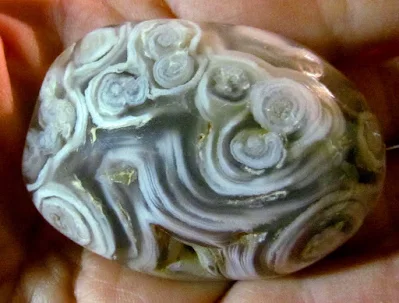 |
| Translucency of the Brazilian enhydro agate. Credit: The Agatelady |
Enhydro agate are nodules, agates, or geodes with water trapped inside its cavity. Enhydros are closely related to fluid inclusions, but are composed of chalcedony. The formation of enhydros is still an ongoing process, with specimens dated back to the Eocene Epoch. They are commonly found in areas with volcanic rock.
Polyhedroid Agate
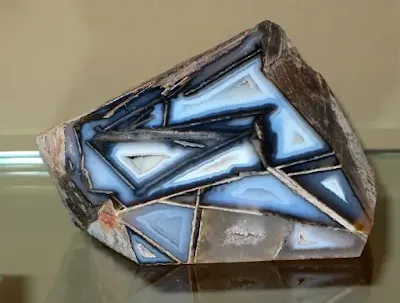 |
| Polyhedroid agate from Pariaba, Brazil. |
Polyhedroid agate is agate which has grown in a flat-sided shape similar to a polyhedron. When sliced, it often shows a characteristic layering of concentric polygons. Polyhedroid agate is thought to be found only in Paraíba State, Brazil. It has been suggested that growth is not crystallographically controlled but is due to the filling-in of spaces between pre-existing crystals which have since dissolved.
Moss Agate
Moss agate is a semi-precious gemstone formed from silicon dioxide. It is a form of chalcedony which includes minerals of a green colour embedded in the stone, forming filaments and other patterns suggestive of moss. The field is a clear or milky-white quartz, and the included minerals are mainly oxides of manganese or iron. It is not a true form of agate, as it lacks agate's defining feature of concentric banding.
Moss agate is of the white variety with green inclusions that resemble moss. It occurs in many locations. The colors are formed due to trace amounts of metal present as an impurity, such as chrome or iron. The metals can make different colors depending on their valence (oxidation state).
Despite its name, moss agate does not contain organic matter and is usually formed from weathered volcanic rocks.
Lake Superior Agate
The Lake Superior agate is a type of agate stained by iron and found on the shores of Lake Superior. Its wide distribution and iron-rich bands of color reflect the gemstone's geologic history in Minnesota, Wisconsin, and Michigan. The Lake Superior agate was selected because the agate reflects many aspects of Minnesota. It was formed during lava eruptions that occurred in Minnesota about a billion years ago.
The stone's predominant red color comes from iron, a major Minnesota industrial mineral found extensively throughout the Iron Range region. Finally, the Lake Superior agate can be found in many regions of Minnesota as it was distributed by glacial movement across Minnesota 10,000 to 15,000 years ago.
Condor Agate
 |
| Condor agate from Argentina |
Condor Agate is primarily found in the mountains of northern Argentina, near the Rio Condor, which is where it gets its name. Condor Agate often exhibits a range of colors, including reds, oranges, yellows, blues, purples, and greens, creating vibrant and eye-catching patterns within the stone. Condor agate was discovered and named by Luis de los Santos in 1993.
One of the distinctive features of Condor Agate is its intricate banding, which can resemble landscapes, abstract art, or even scenes from nature.
Sagenite Agate
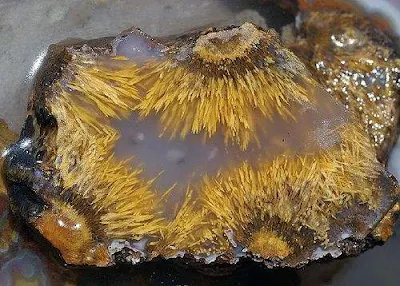 |
| Sagenite Agate |
Sagenite Agate is an agate with acicular or or pointed inclusions of various minerals (mostly rutile). These hair like formations are often arranged in fans or bursts. The crystals are arranged in a fan-like or sunburst pattern, which gives the stone its distinctive appearance. Sagenite agate is found in many parts of the world, including Brazil, Mexico, and the United States. It is a popular gemstone for jewelry and other decorative items.
Fortification Agate
Fortification agate is a type of agate that is characterized by its distinctive banding pattern. The bands are typically sharp-angled and often resemble the outlines of fortifications, such as a castle or a fort. Fortification agates can be found in a variety of colors, including white, yellow, orange, red, brown, and black. They are typically found in sedimentary rock formations, such as sandstone and limestone.
Fortification agates are prized for their beauty and rarity. They are often used in jewelry and other decorative items. Some fortification agates are also considered to be good luck charms.
Fairburn Agate
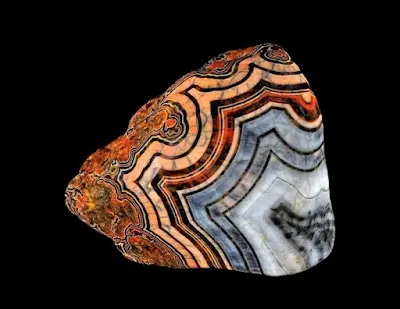 |
| Fairburn agates Locality: Rapid City, South Dakota, United States Photo: © Captain Tenneal |
Fairburn Agate is a unique and rare variety of Fortification Agate from Fairburn, Custer Co., South Dakota, USA. The state gem of South Dakota. Formed in Pennsylvanian-Permian carbonate sediments and weathered out since Oligocene around the Black Hills. Agates in Nebraska formed in Pennsylvanian sediments and were transported from the Hartville uplift in Wyoming in the Oligocene.
Fairburn agates are composed of concentric layers of cryptocrystalline chalcedony colorized by different trace minerals. However, fortification banding distinguishes fairburns from other agate types. Fortification banding means that the concentric layers have sharp changes in direction which cause the bands to form angles in ways which are especially distinguishable from other agate types. Mainly, no other agate type forms these patterns.
Fairburn agates are typically found in a variety of colors, including red, orange, yellow, green, blue, and purple. They can also be found in a variety of patterns, including fortification banding, dendritic banding, and mottled banding.
Botswana Agate
 |
| A Slab of Agate From Botswana. Photo by Avegaon on Flickr |
Botswana Agate is a type of banded agate that is found exclusively in Botswana, a country located in southern Africa. It is known for its intricate banding patterns, which are a result of the stone forming in layers of volcanic ash. Botswana Agate is typically found in shades of white, black, gray, and blue, but it can also be found in other colors, such as red and pink.
Dendritic Agate
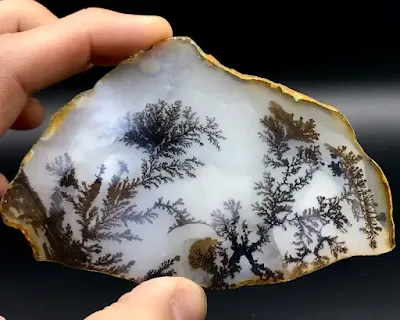 |
| Dendritic Agate from India Photo: LlunaLluviaGems |
Dendritic agate is a popular gemstone and is used in jewelry. It is characterized by its tree-like or fern-like patterns, which are caused by the presence of manganese or iron oxide minerals. Dendritic agate is formed when silica-rich groundwater flows through cracks and fissures in rocks. The silica slowly precipitates out of the water and forms a dendritic pattern. The exact mechanism by which this occurs is not fully understood, but it is thought to be related to the oxidation of iron or manganese minerals.
Coyamito Agate
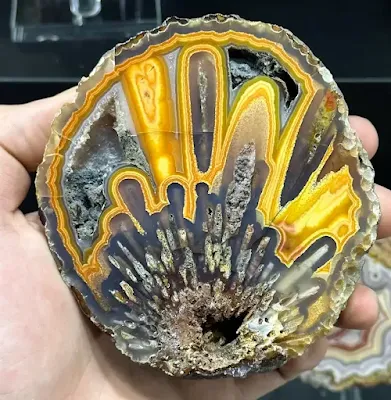 |
| Coyamito Agate |
Coyamito Agate is a specific type of agate that comes from the Coyamito Ranch area in Chihuahua, Mexico. Known for its high occurrence of pseudomorphs. Pseudomorphs are fascinating minerals that form when one mineral replaces another, preserving the original mineral's shape but not its composition. In Coyamito Agate, quartz replaces other minerals like calcite or dolomite, creating unique textures and patterns. Due to the pseudomorphs, Coyamito Agate can exhibit a wide variety of colors and textures. They can be solid-colored, banded, or even have brecciated (fragmented) appearances. Some may even show remnants of the original replaced mineral's structure.
Plume Agate
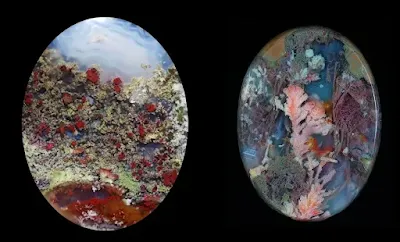 |
| Natural Plume agate |
Plume agate is a type of agate that is characterized by its featherlike inclusions. These inclusions can be a variety of colors, including white, gray, black, and brown. Plume agate is a relatively rare type of agate, and it is often more expensive than other types of agate. Plume agate is formed when iron oxides are deposited in agate in a way that resembles feathers or smoke. The iron oxides can be deposited in a variety of ways, including through volcanic activity, hydrothermal activity, and weathering. It is a rarer type of agate and is often more expensive than other types of agate.
Red Fox Agate
 |
| Red Fox Agate |
Red Fox Agate is a rare and beautiful variety characterized by its vibrant orange, red, and white bands, reminiscent of a red fox's fur. These distinctive bands are often accompanied by botryoidal hematite inclusions, which give the stone a distinctive "foxy" appearance. Red Fox Agate is primarily found in alluvial deposits (loose sediments transported by water) in the Patagonia region of Argentina.
Laguna Agate
 |
| Laguna Agate - Chihuahua, Mexico |
Laguna Agate is a highly sought-after variety of agate known for its vibrant red and scarlet hues with occasional shades of deep red, milky white, yellow, gold, and brown. It is considered the most highly prized banded agate in the world due to its extremely tight banding and intense colors. Found in a remote mountainous region in the state of Chihuahua, Mexico.
Tube Agate
 |
| Tube agate, By: LSAgates |
Tube agate is characterized by hollow, tube-shaped inclusions within the stone. These inclusions come in various colors and often contrast beautifully against a translucent chalcedony background. Its formation involves silica-rich fluids dissolving pre-existing minerals, leaving cavities. Later, these cavities fill with chalcedony, creating the signature tube-like structures through a process called pseudomorphic replacement. Tube agate can be found in various locations worldwide, with notable sources in Mexico, Turkey and Brazil.
The way a tube
agate is cut significantly impacts the visible patterns. Cutting parallel to the length of the tubes reveals elongated, finger-like formations within the stone. Conversely, cutting perpendicular creates a captivating eye or orbicular pattern, showcasing concentric circles.
Conclusion, These names are often used to describe the appearance and origin of the agate. The diversity in colors and patterns makes agate a popular choice for jewelry and decorative items. Keep in mind that there are many local and regional names for specific types of agate, and the classification can vary among different sources.
Black and White Agate Stones (Photos)




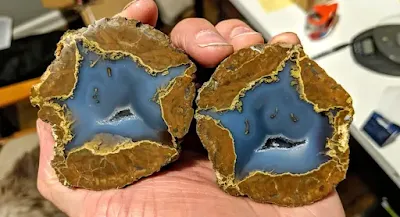






%20(1).webp)



